Good copy = lots of sales.
Poor copy = no sales.
Which one do you want?
Obviously the latter.
However, it’s easier said than done.
Writing good copy requires you to be sharp as an axe.
Businesses often write average or generic copy that hurts their conversion rates and sales.
I’m going to help you avoid that by teaching you 11 product copywriting strategies that will make customers rush to whip out their credit cards.
Enjoy making more money 🙂
1. What are the benefits of the product you’re selling?
Customers have their own interests in mind when buying a product.
They want to know what’s in it for them.
That’s why it’s critical that you focus copy for products around their benefits.
Benefits are the deeper, primal, and emotional reasons why a customer is seeking a product.
This will require you to understand the customer like the back of your hand.
You can do this through research industry reports, sending out questionnaires, and other forms of market research.
Frankly, emotional intelligence might be better than the above strategies.
Being able to use your empathy to step into another person’s shoes will benefit you greatly in copywriting.
It will allow you to see the problems and experiences a customer is facing and then write copy that relates to them.
Here’s a quick video from Gary Vaynerchuk on this exact topic:
With that being said, think about:
- Why your customer wants to buy a product in the first place
- What emotions do they have to prompt the purchase?
- Pain points they are experiencing.
You can then solve these problems within the product copy and elaborate on the reasons why they are interested.
2. Use bullet points to make copy digestible
Since today we’re talking about regular product pages, I highly recommend that you take advantage of bullet points when writing descriptions.
This makes it very easy to digest the features and benefits of a product without needing to read paragraphs or sort through walls of text.
Remember… this isn’t a newspaper we’re writing.
As a matter of fact, statistically speaking, 55% of people skim through web pages in less than 15 seconds and don’t read everything word-for-word.
You can align with this consumer behavior by using short sentences, bullet points, and helping them speed through the sales process.
Look at Amazon, for example. Most product pages have a simple list of the product’s information, like this sneaker:
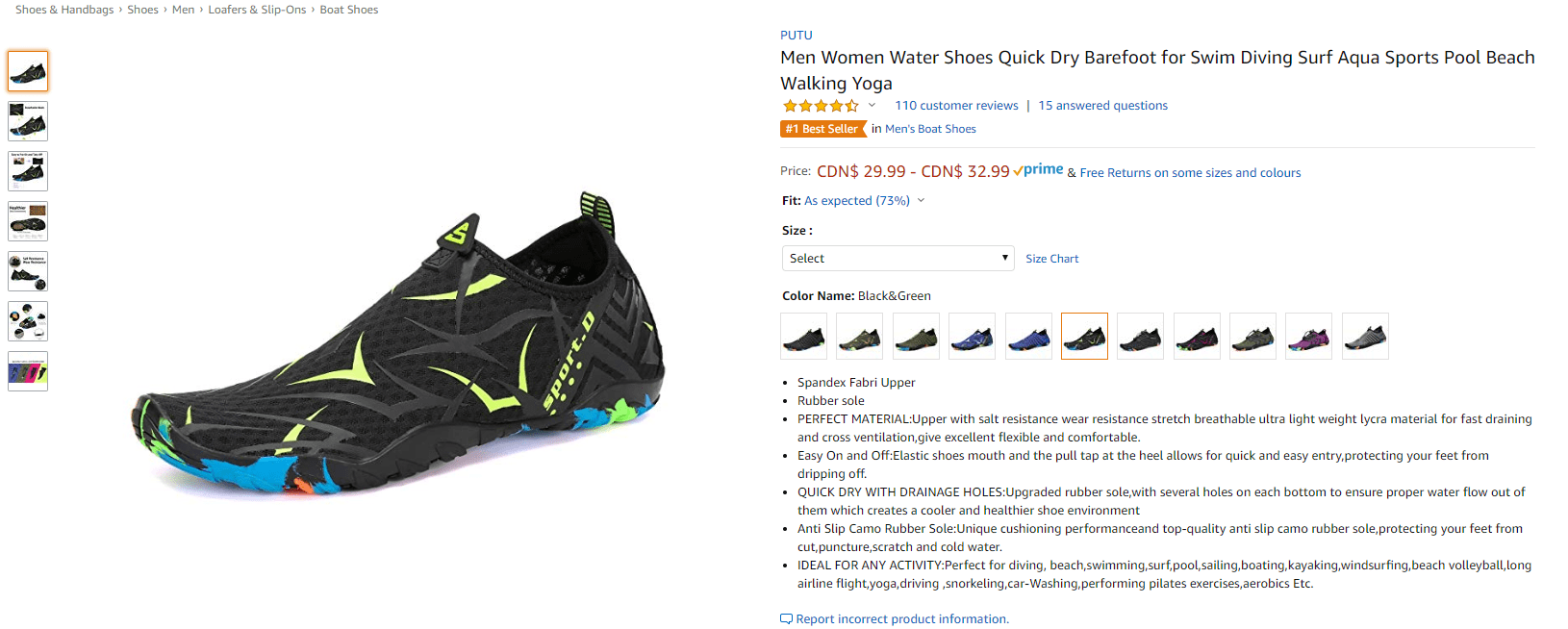
Every bullet should cover a separate feature, idea, or benefit, as well.
3. Help customers imagine using the product
Buying a product, even if it seems small or mundane, is emotional and a lot deeper than most people realize.
That’s why helping customers use their imagination is such a powerful copywriting technique.
By explaining what using the product would be, feel, and look like, you paint a picture in the customer’s mind, and they can see themselves using it.
This also brought out emotions, dreams, and other desires. It inspires the customer to purchase.
And remember, you can’t bore people into buying something; only interest them.
4. Keep your language simple
The average person in the United States has a certain reading level.
If you use complex jargon and fancy words, you’re going to limit the audience you’re able to effectively communicate with.
Think about it from a top-down approach.
Using simple language allows everyone, from an immigrant coal miner to a NASA engineer, to understand your copy.
You can achieve this by doing the following things:
- Use short sentences and paragraphs. This makes copy less intimidating to read and easier to finish.
- Avoid words that only a certain demographic would understand.
- Include the least amount of words possible to make a point.
- Take advantage of a larger font, flat typeface, and generous spacing to make copy easy on the eyes.
Salesforce, the biggest CRM company in the world, pulls this off perfectly on its website.
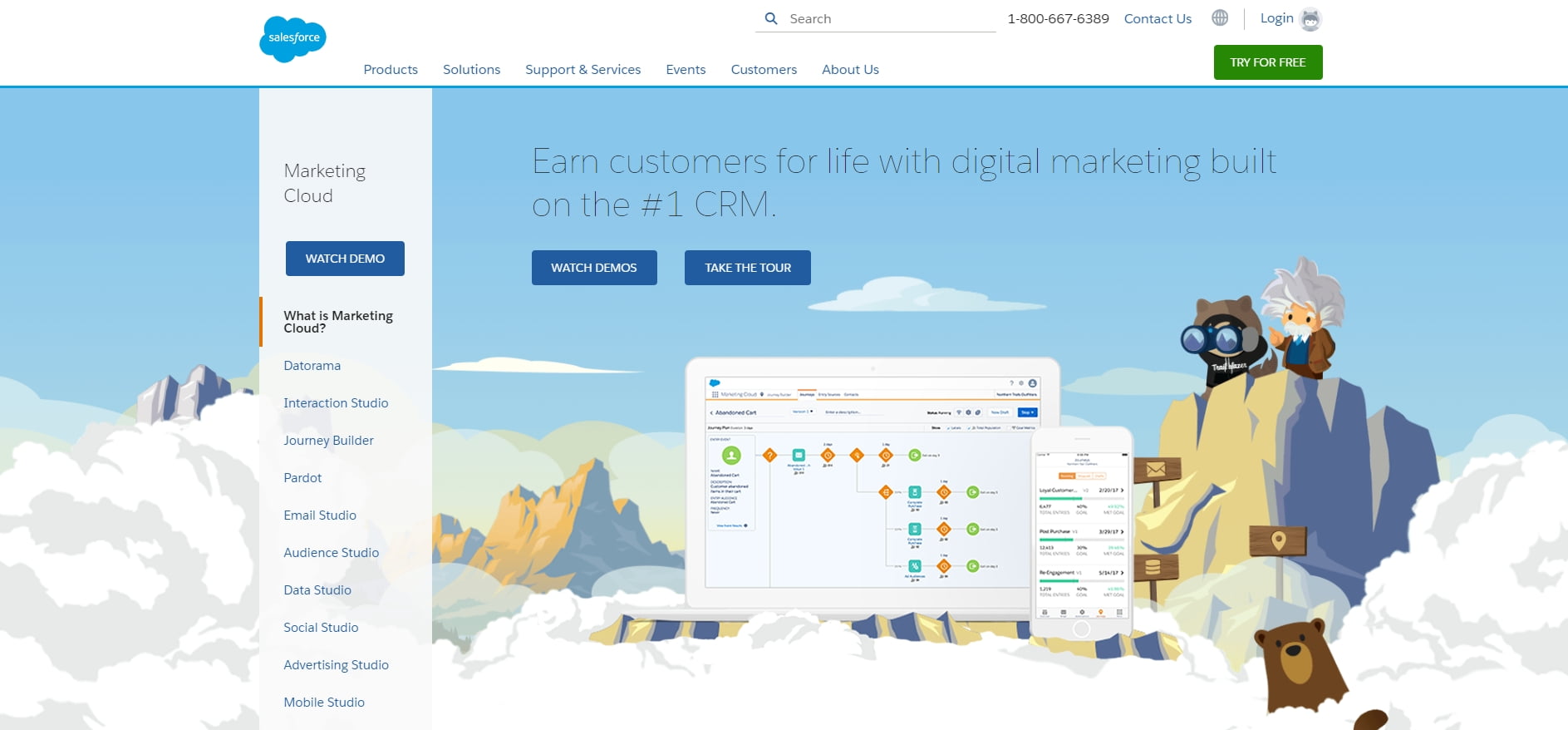
While customer relationship management software isn’t the most basic thing in the world, they sum it up with the headline “Earn customers for life with digital marketing built on the #CRM.”
Furthermore, they sum up product features in a single sentence.
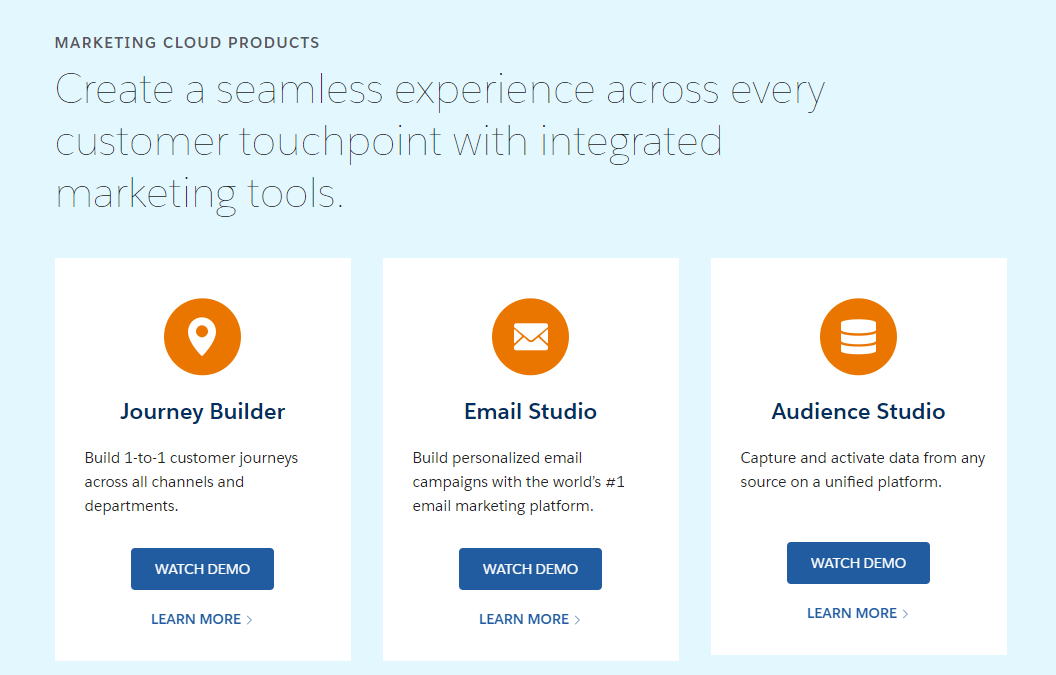
You don’t have to scratch your head wondering what any of the copy means. Aim for that level of simplicity.
5. Sell a cure and not a prevention
One of the greatest copywriters, Joseph Sugarman, coined the strategy of selling a cure and not a prevention.
This is because customers who are seeking a product are already experiencing a problem most likely and require a way to solve it now.
Not tomorrow. Not in two weeks. But now.
However, you can potentially position a product as prevention if it’s something like a health supplement or workout equipment, as you can market it for preventing illness, muscle loss, weight gain, etc.
Furthermore, people will be willing to spend a lot more on a product that solves their problem.
They will feel emotional and maybe even desperate, making the product have a much higher perceived value.
Let’s imagine the following scenario…
A nice gentleman named Greg saw a commercial for a weight loss supplement, and it lightly interested him. He forgot about it soon after.
However, a recent trip to the doctor resulted in him finding out he needed to lose weight if he wanted to live a longer life.
It’s safe to say that he’d be rushing to find out more about that weight loss supplement now because his need is more serious and urgent.
See what I mean?
6. Use power words and calls to action
Power words are precise words and phrases that have big meanings and ideas behind them.
They pack a punch and can be used on product pages, to sum up benefits and paint a picture for the customer without the need for long-winded sentences.
Power words you can include in your product descriptions include:
- Amazing
- New
- State of the art
- Next level
- Luxury
- Affordable
- Innovative
- Premium
- Quality
- Efficient
- Effective
- Massive
- Revolutionary
- Special
- Secret
- Limited
- Special edition
Additionally, entrepreneurs need to also ensure that they use calls to action.
These are sentences that tell customers to take another action that gets them closer to the final sale.
You can add calls to action to your product pages, such as:
- Buy now
- Shop now
- Don’t wait
- Order today
- Add to cart
- Add to bag
Look how this real estate website uses a targeted sales page telling users to search for homes in the Toronto area:
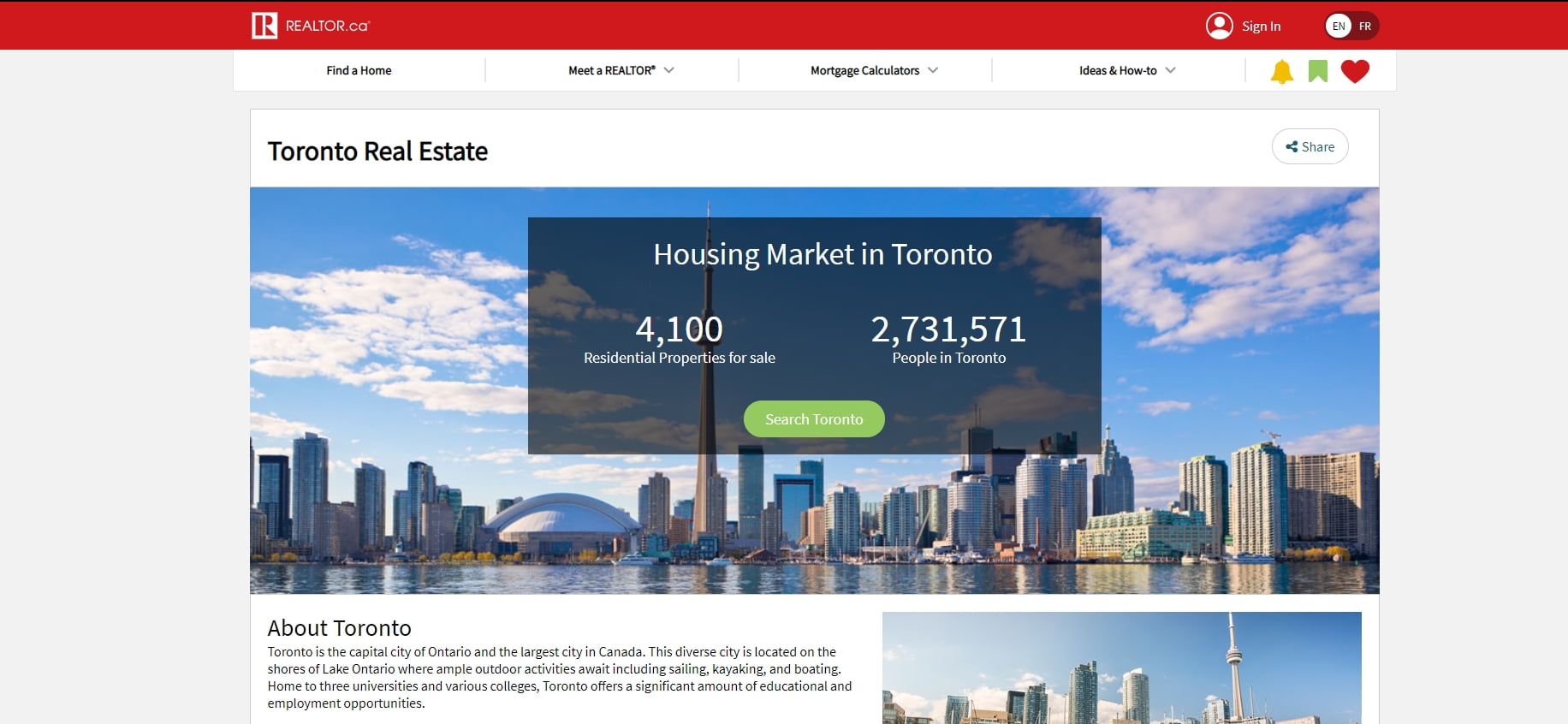
This is also so effective because it removes one fewer step customers have to think about.
7. Use scarcity to create a sense of urgency
One primal human fear that is built into all of our brains is scarcity.
Who wants to miss out on a good deal? Nobody!
That’s precisely why you can take advantage of this human instinct to take action when we believe we’re going to lose something valuable.
One of the best ways to do this is by displaying low inventory numbers on pages for products that are genuinely soon to be out of stock.
I wrote an article on this topic for GoDaddy. You should read here to learn more.
Similarly, you can offer coupons and promotions that only last a certain amount of time which, once again, creates the urgency to take action now.
Look how Shoes.com offered a discount for the month of August and clearly displayed that it expired on a certain date:
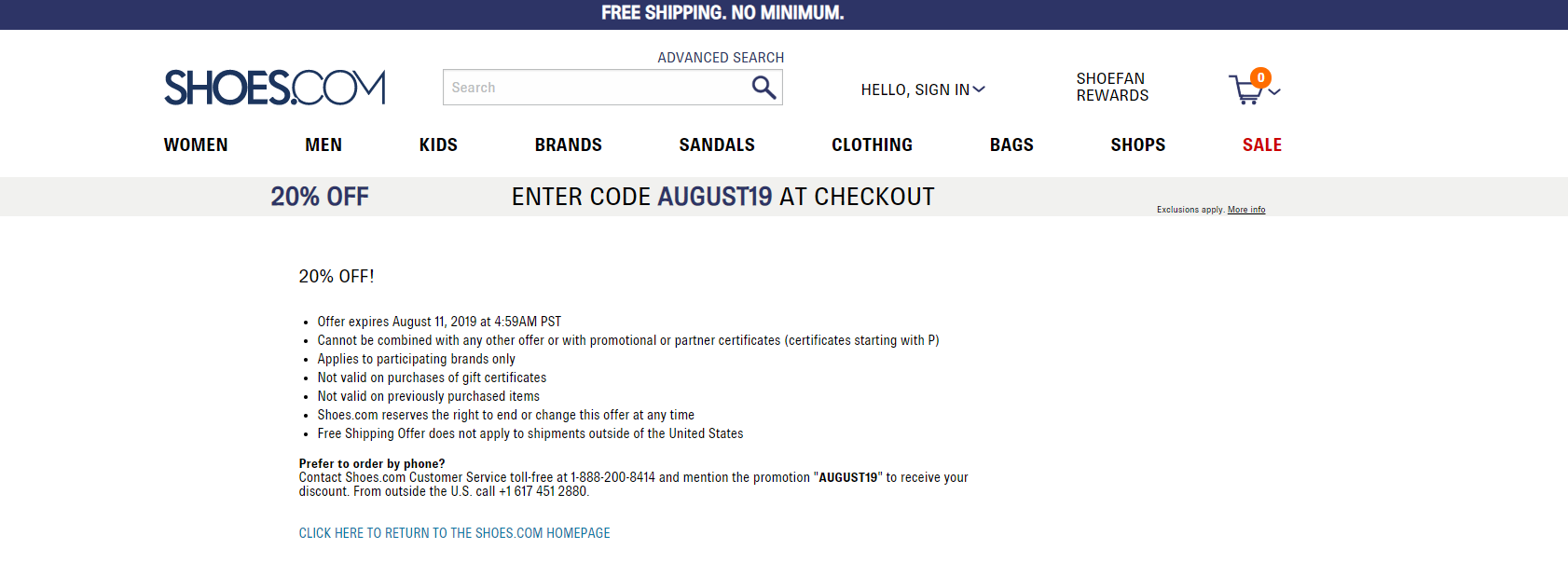
8. Create a template to save time and energy
Last but not least, I highly recommend that every entrepreneur create a product copy template.
Since every product will have different features and quirks, you’re not necessarily going to template the exact copy but rather make an outline you can apply to every new page.
It will look something like this:
- List the features of the product followed by one to two benefits.
- Use one call to action.
- Use two to three power words.
- Agitate one to two paint points.
- Etc
It’s that simple.
You can then apply this template to every product page and the result will be sales copy that elicits emotions, excites customers, and resonates with them on a deep level.
Think about how much better that is than generic copy that will make them want to hit the snooze button.
9. Take a break, eat a Kit Kat
Maybe not literally, but you do need to take breaks on occasion if you write lots of copy.
It’s nice to be able to take a breath of fresh air, let the project sit in, and sleep on the work you’ve done.
That’s why you should schedule healthy breaks like going for a walk, cooking, grabbing a coffee, or another brief activity you can do.
I like reading, meditating, exercising, making music, and journaling.
It’s been proven that focusing on a task for too long actually decreases performance.
The human brain is designed to attack projects quickly and move on to the next thing.
A small break resets this and allows you to apply all of the brain’s resources again.
10. Two brains are better than one
I love critiquing other people’s copy and getting feedback on mine because everybody has a different perspective.
If you need mentorship, check out my copywriting academy.
Sharing copy like this helps you get more ideas to improve it and find errors that you might’ve missed.
Even if your friends and family aren’t David Ogilvy’s prodigy, they will be able to give you insight that you shouldn’t scoff at.
Give your projects to them in your downtime while taking a break, and ask them to leave notes.
If you step up your networking game, which you should, you’ll eventually be surrounded by entrepreneurs and other talented writers to collaborate with.
11. Split test different elements of your copy
There are situations in which changing a single word in a piece of copy drastically improves conversion rates.
Words are that powerful.
Look at Kissmetrics, for example. One of their original home page designs was this:
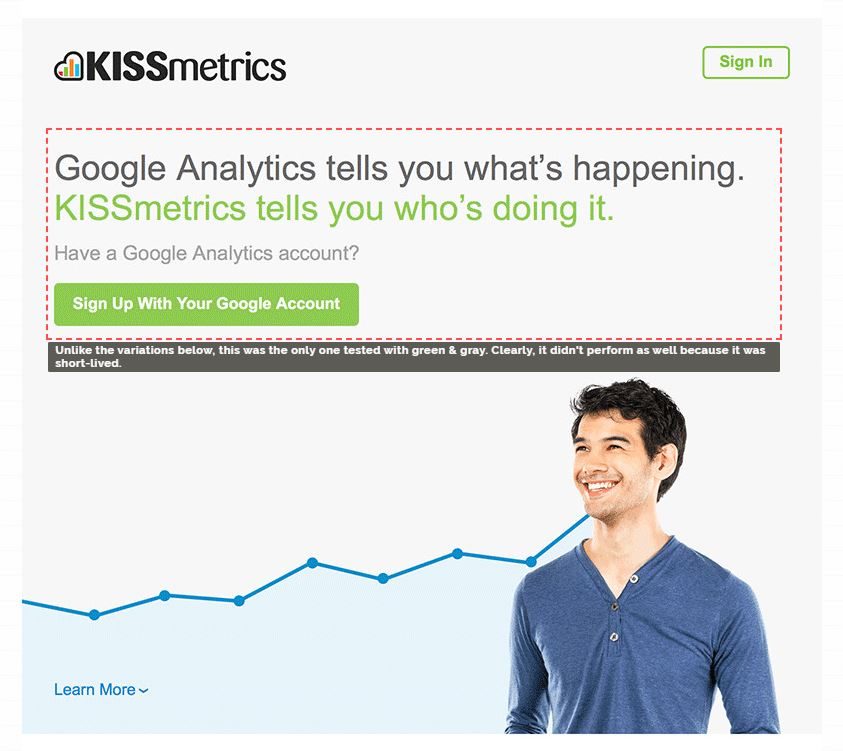
They went through a few different variations in which they changed the copy, images, and colors to test performance.
This was a later variation they stuck with:
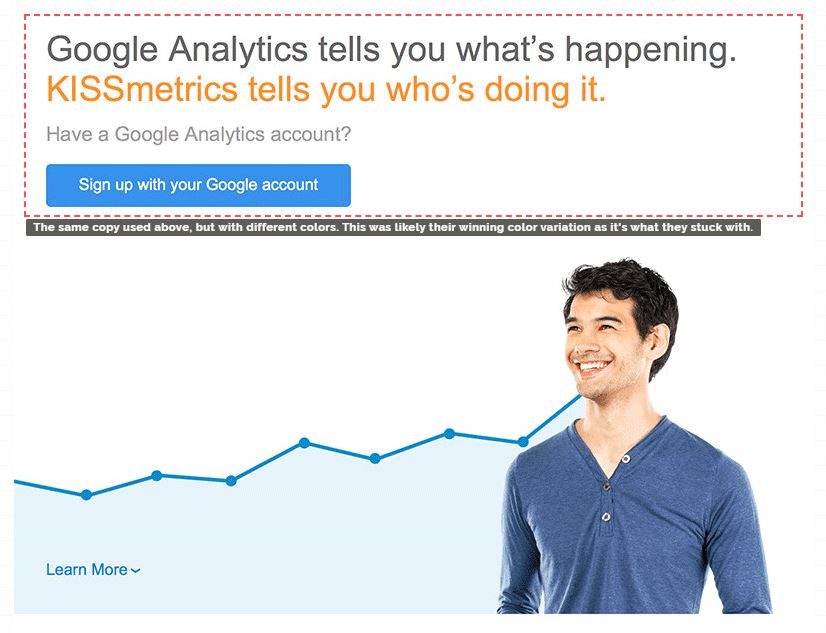
Notice how only the colors have changed. Seeing as Kissmetrics stuck to this version, it clearly improved how many users were signing up.
However, they did test out other variants, including this one:
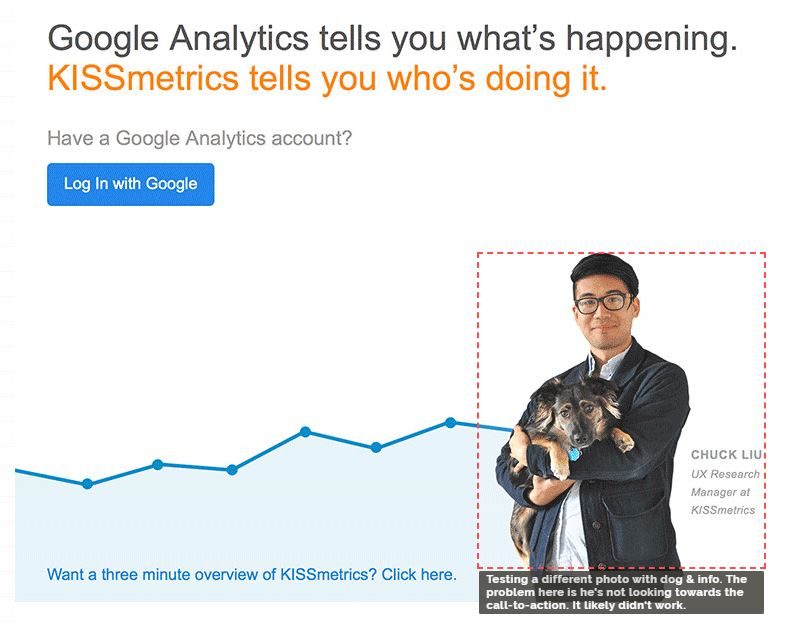
This version included slightly different copy and a new image.
It makes sense that this didn’t perform as well as the other because the man isn’t looking at the signup button, and the CTA is too long.
I wanted to show you this example so you keep split testing in mind when writing product copy.
Try using different calls to action, descriptions, and titles to find winning combinations that convert like crazy.
Wrapping up product copywriting
Good copy can make or break a product page.
It will be one of the deciding factors of whether a customer purchases from you or not.
That means you need to put effort into writing great copy that excites customers and gets them itching to buy on the spot.
You can do so by applying the main takeaways from today’s article below.
Check out my copywriting courses to learn more about product copywriting and more.
- Focus on writing copy which explains the benefits of a product. These are the deeper reasons how a product improves the life of a customer. They are often aligned with a customer’s self interests, as well.
- Use bullet points to make your product pages and descriptions easily digestible. Consider increasing font size and using a flat typography that’s simpler to read.
- Avoid technical jargon and keep your language as simple as possible. This will help you reach a broader audience.
- Position your product as the cure of the customer’s pain point versus a prevention.
- Add power words and calls to action on product pages. These make copy more exciting and help push customers along the sales funnel.
- Use scarcity as a way to encite urgency and action.
- Create a template that you can apply to every new product page. This will speed up the copywriting process, saving you time and energy.














